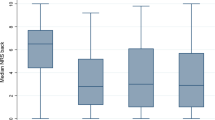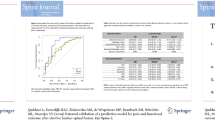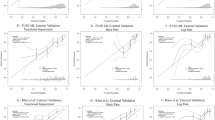Abstract
Purpose
To identify clinical predictors and build prediction models for 1-year patient-reported outcomes measures (PROMs) after lumbar decompressive surgery for disc herniation or spinal stenosis.
Methods
The study included 1835 cases, with or without additional single-level fusion, from a single centre from 2008 through 2020. General linear models imputed with 37 clinical variables identified 18 significant 1-year PROM predictors for retention in development models. Interaction of surgical indication with each predictor was tested. Temporal validation was conducted at the same centre on cases through 2021. R2 was used to measure goodness-of-fit, and area under curve (AUC) used to measure classification to a satisfactory symptom state (Oswestry Disability Index (ODI) ≤ 22; back or leg pain ≤ 30 out of 100).
Results
A total 1228 (67%) had complete data for inclusion in model development. Predictors of ODI were baseline PROMs (ODI, back pain, leg pain), work status, condition duration, previous lumbar operation, multiple-joint osteoarthritis, female, diabetes, current smoker, rheumatic disorder, lower limb arthroplasty, mobility aided, provider status, facet cyst, scoliosis, and age, with BMI significantly associated with stenosis. Temporal validation (n = 188) found the ODI model R2 was 0.29 (95% confidence intervals (CI) 0.18–0.40) and AUC was 0.74 (95% CI 0.67–0.81). Back and leg pain models had lower R2 (0.12–0.14) and AUC (0.68–0.69) values.
Conclusion
Important PROM predictors are baseline PROMs, specific co-morbidities, work status, condition duration, previous lumbar operation, female, and smoking status. The ODI model predicted the likelihood of achieving a satisfactory state of both disability and pain.


Similar content being viewed by others
References
Karhade AV, Fogel HA, Cha TD, Hershman SH, Doorly TP, Kang JD, Bono CM, Harris MB, Schwab JH, Tobert DG (2021) Development of prediction models for clinically meaningful improvement in PROMIS scores after lumbar decompression. Spine J 21:397–404. https://doi.org/10.1016/j.spinee.2020.10.026
Khor S, Lavallee D, Cizik AM, Bellabarba C, Chapman JR, Howe CR, Lu D, Mohit AA, Oskouian RJ, Roh JR, Shonnard N, Dagal A, Flum DR (2018) Development and validation of a prediction model for pain and functional outcomes after lumbar spine surgery. JAMA Surg 153:634–642. https://doi.org/10.1001/jamasurg.2018.0072
Cushnie D, Thomas K, Jacobs WB, Cho RKH, Soroceanu A, Ahn H, Attabib N, Bailey CS, Fisher CG, Glennie RA, Hall H, Jarzem P, Johnson MG, Manson NA, Nataraj A, Paquet J, Rampersaud YR, Phan P, Casha S (2019) Effect of preoperative symptom duration on outcome in lumbar spinal stenosis: a Canadian spine outcomes and research network registry study. Spine J 19:1470–1477. https://doi.org/10.1016/j.spinee.2019.05.008
Aaen J, Banitalebi H, Austevoll IM, Hellum C, Storheim K, Myklebust T, Anvar M, Weber C, Solberg T, Grundnes O, Brisby H, Indrekvam K, Hermansen E (2022) The association between preoperative MRI findings and clinical improvement in patients included in the NORDSTEN spinal stenosis trial. Eur Spine J 31:2777–2785. https://doi.org/10.1007/s00586-022-07317-5
Clement RC, Welander A, Stowell C, Cha TD, Chen JL, Davies M, Fairbank JC, Foley KT, Gehrchen M, Hagg O, Jacobs WC, Kahler R, Khan SN, Lieberman IH, Morisson B, Ohnmeiss DD, Peul WC, Shonnard NH, Smuck MW, Solberg TK, Stromqvist BH, Hooff MLV, Wasan AD, Willems PC, Yeo W, Fritzell P (2015) A proposed set of metrics for standardized outcome reporting in the management of low back pain. Acta Orthop 86:523–533. https://doi.org/10.3109/17453674.2015.1036696
Aalto TJ, Malmivaara A, Kovacs F, Herno A, Alen M, Salmi L, Krger H, Andrade J, Jimnez R, Tapaninaho A, Turunen V, Savolainen S, Airaksinen O (2006) Preoperative predictors for postoperative clinical outcome in lumbar spinal stenosis: systematic review. Spine 31:E648–E663. https://doi.org/10.1097/01.brs.0000231727.88477.da
Iderberg H, Willers C, Borgstrom F, Hedlund R, Hagg O, Moller H, Ornstein E, Sanden B, Stalberg H, Torevall-Larsson H, Tullberg T, Fritzell P (2019) Predicting clinical outcome and length of sick leave after surgery for lumbar spinal stenosis in Sweden: a multi-register evaluation. Eur Spine J 28:1423–1432. https://doi.org/10.1007/s00586-018-5842-3
Perruccio AV, Power JD, Yip C, Badley EM, Canizares M, Rampersaud YR (2021) The impact of multijoint symptoms on patient-reported disability following surgery for lumbar spine osteoarthritis. Spine J 21:80–89. https://doi.org/10.1016/j.spinee.2020.08.005
St-Pierre GH, Yang MH, Bourget-Murray J, Thomas KC, Hurlbert RJ, Matthes N (2018) Performance Indicators in Spine Surgery. Spine 43:275–280. https://doi.org/10.1097/brs.0000000000002309
Staub LP, Aghayev E, Skrivankova V, Lord SJ, Haschtmann D, Mannion AF (2020) Development and temporal validation of a prognostic model for 1-year clinical outcome after decompression surgery for lumbar disc herniation. Eur Spine J 29:1742–1751. https://doi.org/10.1007/s00586-020-06351-5
van Hooff ML, Mannion AF, Staub LP, Ostelo RWJG, Fairbank JCT (2016) Determination of the oswestry disability index score equivalent to a “satisfactory symptom state” in patients undergoing surgery for degenerative disorders of the lumbar spine—a Spine Tango registry-based study. Spine J 16:1221–1230. https://doi.org/10.1016/j.spinee.2016.06.010
Fekete TF, Haschtmann D, Kleinstück FS, Porchet F, Jeszenszky D, Mannion AF (2016) What level of pain are patients happy to live with after surgery for lumbar degenerative disorders? Spine J 16:S12–S18. https://doi.org/10.1016/j.spinee.2016.01.180
Collins GS, Reitsma JB, Altman DG, Moons KG (2015) Transparent reporting of a multivariable prediction model for individual prognosis or diagnosis (TRIPOD): the TRIPOD statement. BMJ 350:g7594. https://doi.org/10.1136/bmj.g7594
Fairbank JC, Pynsent PB (2000) The oswestry disability index. Spine 25:2940–2953. https://doi.org/10.1097/00007632-200011150-00017
Hosmer DW Jr, Lemeshow S, Sturdivant RX (2013) Applied logistic regression. John Wiley & Sons Inc, New York
Glas AS, Lijmer JG, Prins MH, Bonsel GJ, Bossuyt PM (2003) The diagnostic odds ratio: a single indicator of test performance. J Clin Epidemiol 56:1129–1135. https://doi.org/10.1016/s0895-4356(03)00177-x
Rushton A, Zoulas K, Powell A, Staal JB (2018) Physical prognostic factors predicting outcome following lumbar discectomy surgery: systematic review and narrative synthesis. BMC Musculoskelet Disord. https://doi.org/10.1186/s12891-018-2240-2
Gulati S, Nordseth T, Nerland US, Gulati M, Weber C, Giannadakis C, Nygaard ØP, Solberg TK, Solheim O, Jakola AS (2015) Does daily tobacco smoking affect outcomes after microdecompression for degenerative central lumbar spinal stenosis?—a multicenter observational registry-based study. Acta Neurochir 157:1157–1164. https://doi.org/10.1007/s00701-015-2437-1
Wilson CA, Roffey DM, Chow D, Alkherayf F, Wai EK (2016) A systematic review of preoperative predictors for postoperative clinical outcomes following lumbar discectomy. Spine J 16:1413–1422. https://doi.org/10.1016/j.spinee.2016.08.003
Schoenfeld AJ, Bono CM (2015) Does surgical timing influence functional recovery after lumbar discectomy? a systematic review. Clin Orthop Relat Res 473:1963–1970. https://doi.org/10.1007/s11999-014-3505-1
Gullo TR, Golightly YM, Cleveland RJ, Renner JB, Callahan LF, Jordan JM, Kraus VB, Nelson AE (2019) Defining multiple joint osteoarthritis, its frequency and impact in a community-based cohort. Semin Arthritis Rheum 48:950–957. https://doi.org/10.1016/j.semarthrit.2018.10.001
Armaghani SJ, Archer KR, Rolfe RC, Demaio DN, Devin CJ (2016) Diabetes is related to worse patient-reported outcomes at two years following spine surgery. JBJS 98:15–22. https://doi.org/10.2106/jbjs.O.00297
McKillop AB, Carroll LJ, Battie MC (2014) Depression as a prognostic factor of lumbar spinal stenosis: a systematic review. Spine J 14:837–846. https://doi.org/10.1016/j.spinee.2013.09.052
MacLean MA, Touchette CJ, Han JH, Christie SD, Pickett GE (2020) Gender differences in the surgical management of lumbar degenerative disease: a scoping review. J Neurosurg Spine 31:1–18. https://doi.org/10.3171/2019.11.SPINE19896
Rundell SD, Pennings JS, Nian H, Harrell FE, Khan I, Bydon M, Asher AL, Devin CJ, Archer KR (2020) Adding 3-month patient data improves prognostic models of 12-month disability, pain, and satisfaction after specific lumbar spine surgical procedures: development and validation of a prediction model. Spine J 20:600–613. https://doi.org/10.1016/j.spinee.2019.12.010
Zakaria HM, Mansour TR, Telemi E, Asmaro K, Bazydlo M, Schultz L, Nerenz DR, Abdulhak M, Khalil JG, Easton R, Schwalb JM, Park P, Chang V (2020) The association of preoperative opioid usage with patient-reported outcomes, adverse events, and return to work after lumbar fusion: analysis from the michigan spine surgery improvement collaborative (MSSIC). Neurosurgery 87:142–149. https://doi.org/10.1093/neuros/nyz423
Shamji MF, Shcharinsky A (2016) Use of neuropathic pain questionnaires in predicting persistent postoperative neuropathic pain following lumbar discectomy for radiculopathy. J Neurosurg Spine 24:256–262. https://doi.org/10.3171/2015.4.Spine141310
Quddusi A, Eversdijk HAJ, Klukowska AM, de Wispelaere MP, Kernbach JM, Schröder ML, Staartjes VE (2020) External validation of a prediction model for pain and functional outcome after elective lumbar spinal fusion. Eur Spine J 29:374–383. https://doi.org/10.1007/s00586-019-06189-6
Siccoli A, de Wispelaere MP, Schröder ML, Staartjes VE (2019) Machine learning-based preoperative predictive analytics for lumbar spinal stenosis. Neurosurg Focus 46:E5. https://doi.org/10.3171/2019.2.Focus18723
Asher AM, Oleisky ER, Pennings JS, Khan I, Sivaganesan A, Devin CJ, Bydon M, Asher AL, Archer KR (2020) Measuring clinically relevant improvement after lumbar spine surgery: is it time for something new? Spine J 20:847–856. https://doi.org/10.1016/j.spinee.2020.01.010
Acknowledgements
We thank Lennel Lutchman for British Spine Registry compliance and data contribution. We thank present and past physiotherapy staff and administration staff for patient-reported outcome measure collection and collation. We thank present and past Spire Norwich Hospital medical record staff in the hospital records audit. We thank Phillip Mobbs and Adam Geere for programming the researcher resource website and online Web calculator.
Funding
No funds, grants, or other support was received.
Author information
Authors and Affiliations
Contributions
Conceptualization was performed by JHG and ASR; data curation was performed by JHG, GNS, AJC and ASR; methodology was performed by JHG and PRH; formal analysis and investigation were performed by JHG and PRH; writing—original draft preparation was performed by JHG; writing—review and editing was performed by JHG, PRH, GNS, AJC and ASR; supervision was performed by JHG and ASR. All authors read and approved the final manuscript.
Corresponding author
Ethics declarations
Conflict of interest
The authors have no conflict of interest to declare.
Ethical approval
The study was approved by the Spire Norwich Hospital Ethics Committee and the Norfolk and Norwich University Hospital NHS Foundation Trust Audit and Governance Committee (ref:43119).
Additional information
Publisher's Note
Springer Nature remains neutral with regard to jurisdictional claims in published maps and institutional affiliations.
Supplementary Information
Below is the link to the electronic supplementary material.
Rights and permissions
Springer Nature or its licensor (e.g. a society or other partner) holds exclusive rights to this article under a publishing agreement with the author(s) or other rightsholder(s); author self-archiving of the accepted manuscript version of this article is solely governed by the terms of such publishing agreement and applicable law.
About this article
Cite this article
Geere, J.H., Hunter, P.R., Swamy, G.N. et al. Development and temporal validation of clinical prediction models for 1-year disability and pain after lumbar decompressive surgery. The Norwich Lumbar Surgery Predictor (development version). Eur Spine J 32, 4210–4219 (2023). https://doi.org/10.1007/s00586-023-07931-x
Received:
Revised:
Accepted:
Published:
Issue Date:
DOI: https://doi.org/10.1007/s00586-023-07931-x




